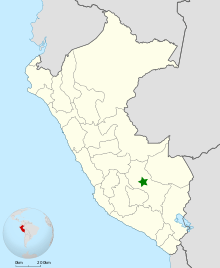Incan little mastiff bat
The Incan little mastiff bat (Mormopterus phrudus) is a species of bat in the family Molossidae, the free-tailed bats. It belongs to the subgenus Micronomus.
| Incan little mastiff bat | |
|---|---|
| Scientific classification | |
| Kingdom: | Animalia |
| Phylum: | Chordata |
| Class: | Mammalia |
| Order: | Chiroptera |
| Family: | Molossidae |
| Genus: | Mormopterus |
| Subgenus: | Mormopterus |
| Species: | M. phrudus |
| Binomial name | |
| Mormopterus phrudus Handley, 1956 | |
 | |
Taxonomy and etymology
It was described as a new species by American zoologist Charles O. Handley. Although the holotype had been collected in 1915 by Edmund Heller, it was not scientifically described until 1956.[2] Its species name "phrudus" comes from Ancient Greek "phroudos," meaning "gone" or "disappeared." Handley chose this name "with allusion to their type locality, the 'Lost City' of Machu Picchu..."[2] Along with Kalinowski's mastiff bat, it is one of only two species of Mormopterus in the New World.[3]
Description
Its head and body length is 50 mm (2.0 in); its tail length is 29 mm (1.1 in); its forearm length is 34 mm (1.3 in).[2] Its fur is dark brown.[3] Its ears are thin, rounded, and not conjoined as in some other free-tailed bats. It has a small tragus with a pointed tip and an inconspicuous antitragus. Its lips are slightly wrinkled. Males, at least, have a gular gland. Its dental formula is 1.1.2.32.1.2.3, for a total of 30 teeth.[2]
Biology and ecology
Little is known about the biology of the bat. It has been observed roosting in caves at an altitude of 3,000 m (9,800 ft). It may be a microendemic species.[1]
Range and habitat
It is only known from a very small area of occupancy of 20 km2 (7.7 sq mi). It is documented at relatively high elevations, from 1,800–3,000 m (5,900–9,800 ft) above sea level.[1] It occurs in lowland subtropical forest.[3]
Conservation
This bat is endemic to Peru, where it is known only from one location; its type locality at Machu Picchu. It is considered a vulnerable species by the International Union for Conservation of Nature (IUCN) and a critically endangered species by the nation of Peru; though it is rare, it lives in a protected area.[1]
References
- Velazco, P. (2016). "Mormopterus phrudus". IUCN Red List of Threatened Species. 2016: e.T13887A22083688. doi:10.2305/IUCN.UK.2016-2.RLTS.T13887A22083688.en.
- Handley, C. O. (1956). "A new species of free-tailed bat (genus Mormopterus) from Peru". Proceedings of the Biological Society of Washington. 69: 197–199.
- Gardner, Alfred L. (15 September 2008). Mammals of South America, Volume 1: Marsupials, Xenarthrans, Shrews, and Bats. University of Chicago Press. p. 427–428. ISBN 978-0-226-28242-8.
